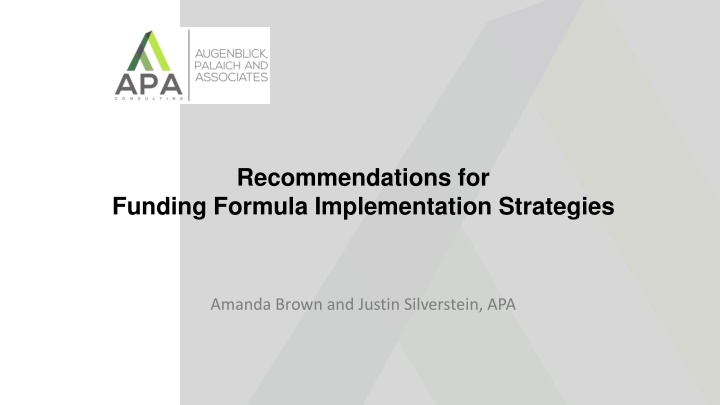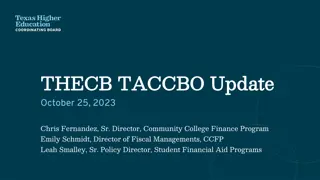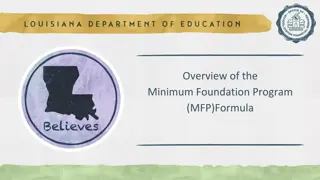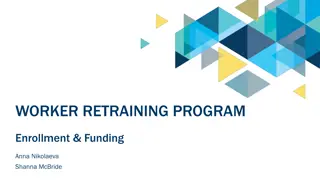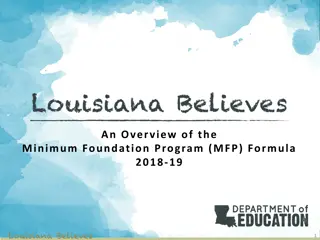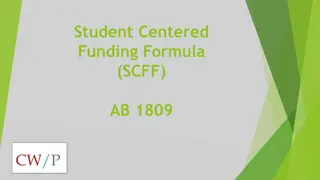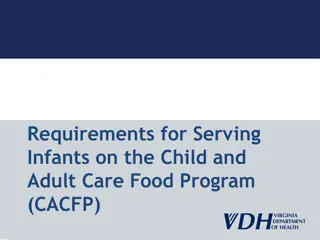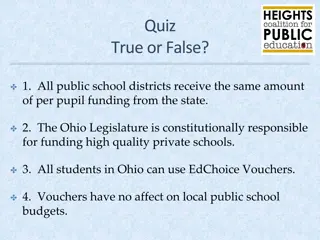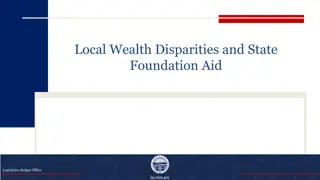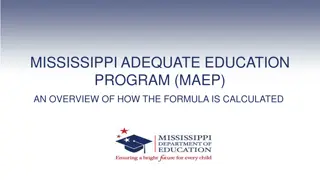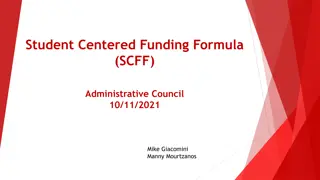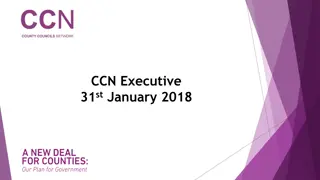Funding Formula Implementation Strategies Overview
National overview of funding formula implementation strategies, highlighting states that have adopted new funding formulas since 2000. Discussion on phases of formula implementation and recommendations for successful implementation.
Uploaded on Feb 22, 2025 | 0 Views
Download Presentation

Please find below an Image/Link to download the presentation.
The content on the website is provided AS IS for your information and personal use only. It may not be sold, licensed, or shared on other websites without obtaining consent from the author.If you encounter any issues during the download, it is possible that the publisher has removed the file from their server.
You are allowed to download the files provided on this website for personal or commercial use, subject to the condition that they are used lawfully. All files are the property of their respective owners.
The content on the website is provided AS IS for your information and personal use only. It may not be sold, licensed, or shared on other websites without obtaining consent from the author.
E N D
Presentation Transcript
Recommendations for Funding Formula Implementation Strategies Amanda Brown and Justin Silverstein, APA
Presentation Overview Review of national information on funding formula implementation strategies from the Education Commission of the States Identification of states that have adopted or significantly revised their funding formulas in the past twenty years Discussion of state implementation strategies Recommendations to the Commission for the successful implementation of the new funding formula 2
States with New Funding Formulas Since 2000 Since 2000 the following states adopted new school funding formulas, or significantly modified their prior formulas: Year 2001 2002 2010 2013 2013 2014 2015 2017 2019 2019 2019 State Wyoming Arkansas Rhode Island California Ohio Kansas Pennsylvania Illinois Massachusetts Nevada Texas Type Prompted by litigation Prompted by litigation Legislative led Governor led/voter approved Prompted by litigation, then legislative led Prompted by litigation, then legislative led Legislative led Legislative led Legislative led Legislative led Legislative led 3
Phases of Formula Implementation Based upon the work of Education Commission of the States nationally about common state concerns and approaches to new funding systems, APA has categorized three phases of new formula adoption: Determining Formula Parameters This phase addresses questions that arise such as: Will current grant programs be maintained, or will they be rolled into the formula? Will any area of funding not be addressed in the new formula (capital, transportation, food services)? How will students be counted? Will funding be adjusted for district size, cost of doing business or geographic location? How will the state determine the wealth of a district? 4
Phases of Formula Implementation, continued Implementation Transition This phase may include: Determining funding targets Gradually transitioning to the new funding formula Ensuring that funding levels for individual districts are held harmless or creating minimum payments in the formula Allowing for certain mandates or programs be retained Stakeholder Engagement and Education This phase would include engaging and educating both the public and school districts about the new formula to addresses concerns such as: How the new system functions What impact changes in the system have on overall funding for schools Beliefs that a loss of mandates may result in some programs being eliminated 5
Where is Nevada in this Process? The Commission has completed the Determining Formula Parameters phase Subject to revision The Commission has moved into the Implementation Transition phase Discussions of optimal funding Identifying new revenue streams and phase in targets The recently adopted recommendations from WestEd include next steps for the Stakeholder Engagement and Education phase 6
Highlighted States Of the states with new funding formulas since 2002, APA identified several recent examples that were legislative or governor led for further review, and disaggregated those by the degree of change: New Formula Adoption California Illinois Maryland Pennsylvania Rhode Island Significant Modification to Prior Formula Massachusetts Texas 7
Key Questions for Review of Other States How did each state revise their funding formula? Approach basis? Student-centered? Weighted? More or less categorical funding? How did each state phase in its new funding model? Funding increase targets for each year? Targeted dollars to certain groups? Targeted to districts farther from adequacy? Did the state include a hold harmless provision? If the funding formula revision occurred during the recession or economic downturn, how did the state handle it? 8
California New System: California's local control funding formula (LCFF) was enacted in 2013 14, replacing a finance system that had been in place for 40 years Consolidated over 50 state categoricals and separate funding streams Established a base fund amount, with adjustments for grade levels, a supplemental weight for low-income, English learners or foster youth, a concentration weight, and a necessarily small schools adjustment Also included a minimum guarantee (hold harmless) set at a district s 2012-13 funding level, adjusted for changes in student population Phase In: Original 2013-14 estimates provided by the Department of Finance (DOF) in California indicated there would be an additional state cost for LCFF implementation of approximately $18 billion and that it would take eight years to fully phase in the new funding formula Between 2013-14 and 2018-19, the legislature provided between an additional $1.4 to $6.0 billion in funding each year, allowing all schools districts and charter schools to be fully funded ahead of the original eight-year schedule 10
Illinois New System: In 2017, Illinois adopted a new student-centered funding formula, using an evidence-based approach (27 components make up the base) The new system also moved from categoricals to weights Has hold harmless provision in place Set an adequacy target for each district Phase In: Illinois has set a target of an additional $500 million each year, with dollars being targeted to districts based upon their distance from their adequacy target Districts are grouped into 4 tiers Tier 1: below 60% of their adequacy target receive 50% of the new funding Tier 2: 60- 90% of their adequacy target receive 49% of the new funding Tier 3: 91 100% of their adequacy target receive 0.9% of new funding Tier 4: more than 100% of their adequacy target receive 0.1% of new funding 11
Maryland New funding system (2002): included a foundation amount but collapsed the funding that was previously provided through over 50 categoricals dramatically and instead included targeted weighted funding for special education, compensatory education (economically disadvantaged) students, and English Learners The system implemented the highest comp. ed. and LEP weights in the country, nearly 1.0 for both student populations State and local funding expectations are set based on the wealth of the community which each of the four formulas having separate equalization calculations, though locals are not required to fund their local share of targeted funding 12
Maryland, continued Phase In: Maryland chose to phase in the figures over time utilizing cost-of-living adjustments to keep up with the adequacy levels The implementation never fully happened due to the 2008 economic downturn Recent developments: Maryland recently revisited their formula via another adequacy study and a Commission Legislation was passed in March, but vetoed by the governor in May due the anticipated economic impact of the pandemic 13
Pennsylvania New System: Pennsylvania s Fair Funding Formula was developed in 2015 by the Basic Education Funding Committee The system recognizes adjustments for poverty, acute poverty, high concentrations of acute poverty, charter students, and sparsity. State and local share is determined by local capacity, effort, and income levels setting appropriate state share Note, PA previously adopted a new funding formula based upon an adequacy study, that was not implemented due to political administration changes and the 2008 recession 14
Pennsylvania, continued Phase In: the new system is only funded with new dollars into the system, with 2014-15 set as a base year of funding for districts The formula does not identify a funding figure for each district but instead a share of the total new funding allocated by the state. For example, a district might earn 1.2% of the total new pot of funds. As total funding for K-12 grows the Fair Funding Formula will become a greater share of the total funding amount 15
Rhode Island New System: Until June 2010, Rhode Island was the only state without a true funding formula. The new system included: Core instructional cost for each student based upon evidence-based resource components (base) Student success factor to support students from low-income backgrounds Categorical funding for high-cost special education students, early childhood, career & technical programs Determinants of state aid to districts based on local fiscal capacity and concentrated poverty Adjustment for inflation using the Consumer Price Index Phase In: Districts receiving more state aid were phased into full funding in 7 years. Districts receiving less state aid were reduced over ten years. 16
States that Significantly Modified Prior Formulas 17
Massachusetts System Changes: Approved in the fall of 2019, the changes are the result of a 2015 Commission s finding that adjustments were needed to provide adequate and equitable funding to districts. These changes include: The calculation used to estimate district employee health care costs Increases special education enrollment and cost assumptions (census-based funding) Increases funding for English Learners Addresses concentrations of low-income students in districts Additional state financial support to help districts in certain targeted areas: student mental health, charter reimbursements, extraordinary special education costs, and capital 18
Massachusetts, continued Phase In: The Student Opportunity Act included $1.5 billion in new funds There are different phase-ins for different pieces of the funding increases: Charter reimbursement is to be phased in over 3 years Special education is to be phased in over 4 years (25% coming in the first year) Other areas phased in over 7 years There is a hold harmless provision, through the calculation of a minimum aid adjustment, to ensure no districts are harmed by any changes in this bill 19
Texas System Changes: In 2019, Texas passed legislation to increase funding for education and modify the state s current funding formula. Changes included, but are not limited to: Increasing the base allotment Increasing teacher salaries Creating additional weights for early education for low-income students and English learners, for dyslexia, and dual language programs Increasing the special education and compensatory education weights Replacing prior high school weight with specific funding for CTE expansion and graduation incentives Providing targeted resources for extended learning opportunities 20
Texas, continued System changes, continued: Increasing small districts adjustments, and amending the adjustments so that it doesn t multiply other student factors, except for special education Funding gifted and talented through a census approach vs. identification Eliminating outdated regional cost adjustment Phasing out 1992/93 hold harmless at 20% reduction each year Reducing property taxes Phase In: No phase in, new funding allocated at time of bill signage $6.5 billion in new public education spending, plus about $5.1 billion for lowering property taxes Increased funding about $650 per student, on average 21
Summary of State Implementation Approaches In states adopting new formulas, they tend to be streamlining categoricals and moving towards student-centered funding systems Nearly all states used a phase in approach to funding Set specific targets for funding levels Targeted resources in the interim based upon: Specific student groups Distance from adequacy targets Equal distribution to districts Most included a hold harmless provision 22
APA Recommendations With the established priorities of equity and transparency, APA recommends that the Commission: Determine how new funds will be distributed to first meet adopted aspirational weight levels Develop implementation funding phase in targets to reach optimal funding levels Allow for hold harmless 23
Determine How to Distribute New Funds: Meeting Aspirational Weights The initial implementation of the PCFP is focused on keeping the base whole and establishing effective weights based upon the level of funding provided under the Nevada Plan for these student groups through categoricals Aspirational weights have also been adopted that are higher than effective weights Commission should establish how to target any additional funding needed to reach aspirational weights. Options include: Proportional investments: based on the distance from aspirational for each weight Targeted investments: new dollars allocated to weights based on a set of defined priorities 24
Options for Meeting Aspirational Weights Proportional Investments In this approach, weights would be proportionally adjusted up based on available revenues until aspirational weights are met This does mean the weight further from aspirational will always be further behind until full weights reached Does ensure that if phase in is interrupted, each weight has made progress towards aspirational Targeted Investments Commission could determine to close the gaps of the weights differentially, putting earlier funding into one weight over the other either entirely or just differentially This approach provides ability to show priorities If there is an interruption in phase in, may mean one weight is much further behind than the other 25
Options for Meeting Aspirational Weights: Example Comparison 26
Determine How to Distribute New Funds: Implementing the Waterfall Once aspirational weights are met, then new dollars should flow through the waterfall Aspirational weights were based upon the adequacy study s relative weights, meaning that the intent was to keep the same relative relationship between the base and weights as new dollars were added to the system to reach adequacy targets However, if the relationship of base and weights for optimal is not the same as what was set as part of the adequacy discussion, then the Commission would have to similarly determine proportional vs. targeted investments 27
Phase In of New Funds In addition to determining how to distribute new funds (proportional vs. targeted investments), the Commission will need to set targets for when the funds will be provided Any new funding will likely be phased in over time and needs to be aligned with revenue generation Determine how additional revenue can be raised and the flow of that additional revenue across years APA would recommend two phases of implementation: reaching aspirational weights first, then targeting optimal funding Address annual inflation/cost of living increases Allow for hold harmless 28
Questions? 29
